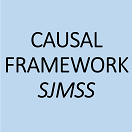Causal framework for running-related injuries
New RUNSAFE article in Scandinavian Journal of Medicine & Science in Sports (SJMSS)

It is with great enthusiasm that RUNSAFE together with our Australian collaborators present a new article entitled “A framework for the etiology of running-related injuries” with Ph.d. student Michael Bertelsen as lead author. This article has been accepted by Scandinavian Journal of Medicine & Science in Sports (SJMSS).
Why a framework?
“How much running is too much?”, you may ask. To respond to that question, one needs to consider how much running athletes with different characteristics can tolerate before being at high risk of injury. Many variables should be taken into account. To name a few, these may be: number of steps, body weight, previous injuries, running speed, surface, shoes and terrain. Still, these variables needs to be organized in a pattern to understand why injuries develop. If we don´t organize them, we are able to identify sub-group of runners at decreased or increased risk of injury. But the reason why they sustain injury will remain hidden. That´s why a causal framework is needed.
Running is a central part
In the framework, we consider running as a central part of the causal path. Running interacts with magnitude-related (e.g. body weight, running speed) and distributed-related variables (running shoes, surface, technique) to produce a structure-specific cumulative load per training session. If this load exceeds the load capacity over one or more sessions, injury will occur.
Outstanding reviewers
We don´t know who you are. Still, we would like to express our deepest acknowledgements to the reviewers. Their comments, feedback and valuable critique during the review process were extremely valuable and thought-provoking. Thank you – we appreciate that you spend many hours on reading and commenting!
A time-consuming process
A times, research takes time. In this particular case, the first full-text draft to the article is dated January 13th 2013. Before this, we have had a couple of years with valuable discussions. As you can see, this baby was hard to get out. Mostly because the though-provoking, in-depth discussions took a lot of time. Today, we are proud of the work and we hope that runners, coaches, clinicians and researchers find it usable and understandable.
Link to article
Please find the full-text version of the article at the SJMSS homepage here
